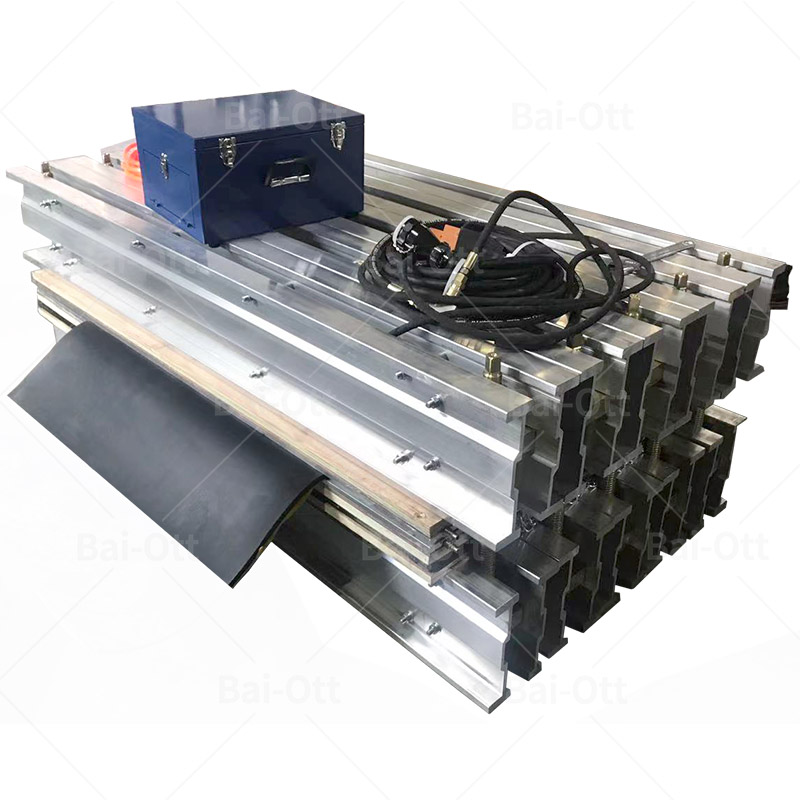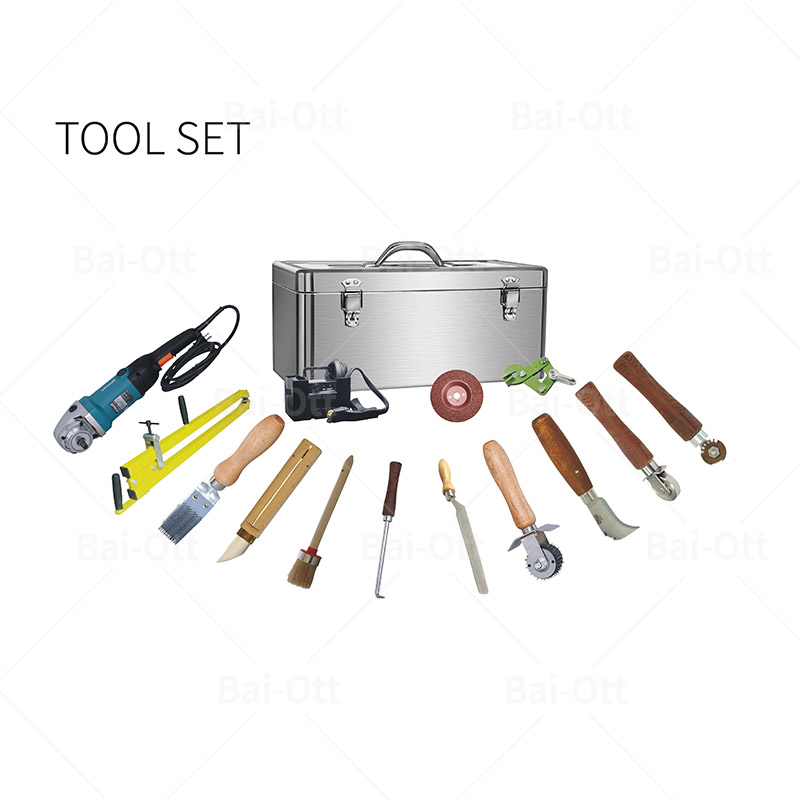Analysis of pulley lagging for belt conveyor drive drum
Introduction
The main transportation equipment in the production operation of bulk cargo terminal is belt conveyor, which completes all the transportation work from the storage yard to the cabin. Belt conveyor is an important port coal handling equipment, which mainly carries the transportation of coal. Therefore, the bearing load of belt conveyor directly determines the throughput of the wharf. The key component of the belt conveyor is the transmission drum, which directly determines the exertion of the generation capacity of the belt conveyor and the safe operation of the equipment. By increasing the friction between the bearing belt and the driving drum and eliminating the driving failure, the reliability and stability of coal loading and unloading can be effectively increased.
Process problems in rubber coating of transmission drum
The belt conveyor mainly realizes the transportation of materials through the friction between the conveyor belt and the transmission drum. In the past, the rubber wrapping process of the transmission drum is to cut the belt conveyor according to the size of the drum, then bond the belt on the drum with adhesive, and press the joint with screws, while ensuring that the joint is flat. However, in practical application, it is found that it has the following two problems: ① there is the problem of poor joint connection. Due to manual cutting when cutting the belt conveyor, the joint cannot be close to the drum, and the distance between the compression screw and the belt edge is 30mm, resulting in the accumulation of conveyor materials at the joint during operation. With the increase of time, the accumulation also increases, and the glue wrapping damage becomes more and more serious, resulting in serious deviation or slip during transportation, Serious will cause damage to the tape. ② The performance of the adhesive is poor. This kind of adhesive has high requirements for the construction environment, and the normal work can be restored only 2 hours after the bonding is completed. Especially after high-temperature water immersion, its adhesion is significantly reduced, and it is easy to degumm between the drum and the tape, causing the tape to peel off or even tear.
In addition, In order to increase the friction between the belt and driving roller, will often flame retardant rubber bond in transmission roller surface, rubber bonding way has two kinds of cold sticky and hot vulcanization, but after practical application, the rubber have fall off and wear condition, to reduce the friction and transmission capacity at the same time could lead to a skid phenomenon, therefore, need to replace the replacement of the whole drum or plastic bags, increased Cost and man-hours.
Main inducement of wear of drum packing glue
Roller coating is usually rubber products, which is a microscopic layered structure, through the observation of the wear of roller coating found that there are two main manifestations of wear: one is the fracture of the tongue caused by tensile action; the other one is the periodic tearing of tiny tongues on the surface of the coating. Such behavior usually occurs in a large area, so it is easy to have typical abrasive wear, which belongs to macro wear. Some scholars have studied different reasons leading to the wear of rubber wrap in the drum, and found that if the environment is more sprayed by coal dust and there is a large positive pressure between the rubber wrap and the conveyor belt, the wear of rubber wrap will be more serious, and the drum needs to be replaced frequently. By summarizing the relevant data and the actual knowledge of rubber wear and roller wear, it is found that there are three main reasons for the gumming of the driving roller :(1) when the tension of the conveyor belt changes, the gumming of the driving roller has elastic friction; (2) There is positive pressure between the transmission rolling and the conveyor belt; (3) There are coal dust particles and other wear media between the driving drum and the conveyor belt.
Wear mechanism of the driving drum
Wear refers to the relative movement of the friction surface, due to chemical action, mechanical action caused by the phenomenon of material shedding. Relevant studies point out that the main reason leading to the wear of the driving drum is the relative movement of the rubber and the contact medium under a larger positive pressure. Therefore, the research on the mechanism of driving drum package adhesive wear, influential found the following factors: (1) contact medium, belt conveyor in coal transportation more applications, therefore, a large number of coal particles can exist in the conveyor belt and driving roller between Jane plastic bags, through field observation found that this kind of contact between the conveyor belt and driving roller medium in the distribution range, thickness is Evenly distributed; (2) the effect of positive pressure, the tension of the conveyor belt is the main positive pressure, the belt conveyor wants to normal operation, it needs to increase the tension of the conveyor belt, so as to avoid the operation, start and stop skidding phenomenon; (3) The relative movement between the contact medium and the driving drum wrapping glue, such relative movement can be divided into two kinds: one is the belt conveyor operation due to the friction torque between the drum wrapping glue and the conveyor belt, so the conveyor belt on both sides of the rolling tension is different; The second is the relative movement between the belt conveyor and the drum when it starts or stops.
Types and characteristics of wrapping glue for lower driving drum
At present, the adhesive types of belt conveyor include cold adhesive, ceramic adhesive, tile shell type adhesive, casting adhesive and other types, different adhesive methods have different characteristics.
First, Hot vulcanized pulley lagging Its main advantage is that there is no gap between the rubber surface of the drum and the drum, the contact surface is larger, the coating layer is firm and reliable. Its shortcomings are mainly the following 3 points: (1) because of its uneven thickness, so the need for secondary processing after casting, in order to ensure the coaxiality of the rolling shaft and the rolling circle, with higher equipment requirements. (2) If the barrel skin and rubber surface are removed during use and cannot be repaired, the drum must be removed, and then the outer rubber is removed and re-wrapped. ③ Before casting the glue, the threaded groove should be processed on the whole surface of the cylinder to increase the strength and contact area of the glue.

Second, Cold vulcanized pulley lagging Its advantages are: compared with casting glue, its production is more simple, and there is no need to use large equipment, uniform coating. The deficiencies mainly include the following three points: (1) After use, if the rubber plate comes off, it is necessary to remove the roller to remove all the rubber plate and then clean it, and finally re-bond the rubber plate, which is difficult to repair; (2) Before operation, it is necessary to clean and pack the rolling Jane, so that it is in a smooth state, and there is no oil pollution on the surface; (3) When wrapping the glue, ensure that there is no gap between the rolling Jane and the glue plate, otherwise it will affect the strength of the glue.

Third, Tile shell pulley lagging The continuous development of the machinery industry promotes the continuous improvement of the packaging process. Now there are two widely used packaging methods, one is tile shell type packaging; The other is ceramic wrap glue. Tile shell type glue is mainly composed of rubber plate and batten. When batten is installed, it should be welded to the surface of the roller and the rubber plate should be pressed tightly. It is mainly formed by metal layer and wear-resistant rubber layer through hot vulcanization operation. Its advantages are as follows: (1) Simple operation and strong reliability when installing rubber plate; (2) If the surface of the rubber plate is damaged or worn during use, it can be replaced on site. Only the damaged rubber plate can be removed, and the roller does not need to be removed. This reduces downtime, reduces costs and improves efficiency. (3) When wrapping glue, only rough machining on the surface of the drum is required to achieve a satisfactory degree of finish, which is lower than cold viscose. (4) The rubber plate is formed of new materials and new technology, long life and wear resistant rubber layer. It can be seen that compared with casting glue and cold viscose glue, wacker drum glue is simple to make and easy to maintain. It can not only effectively prolong the service life of rolling Jane, but also reduce the maintenance cost, and can be adapted to all kinds of drum specifications.

Fourth, Ceramic head drum pulley is a more advanced coating method. It inserts 20 mmx20 mm aluminum oxide ceramic blocks with good wear resistance and particles on the surface into special rubber. Because the contact surface between rubber and ceramic has dovetail groove structure, they can be tightly combined and the rubber is not easy to come out.In addition, the ceramic sheet has high roughness and bumps on the surface, which can increase the friction coefficient and effectively avoid slipping. The ceramic lining plate has no layer, firm adhesion, good wear resistance and relatively long service life. Compared with the conventional rubber coating, its service life is 3 ~ 5 times longer, which can avoid multiple rubber coating maintenance 0. At present, ceramic roller coating and tile shell coating are widely used in belt conveyors in various fields, such as chemical industry, metallurgy, ports, mines and other fields.

To sum up, with the continuous introduction and promotion of new structures and technologies, the reliability and stability of the equipment during operation are increasing. Through technical means, reduce the shutdown time of the belt conveyor, improve the operation stability and management level of the equipment, reduce the labor degree during maintenance, and make sure the operation of the equipment.






